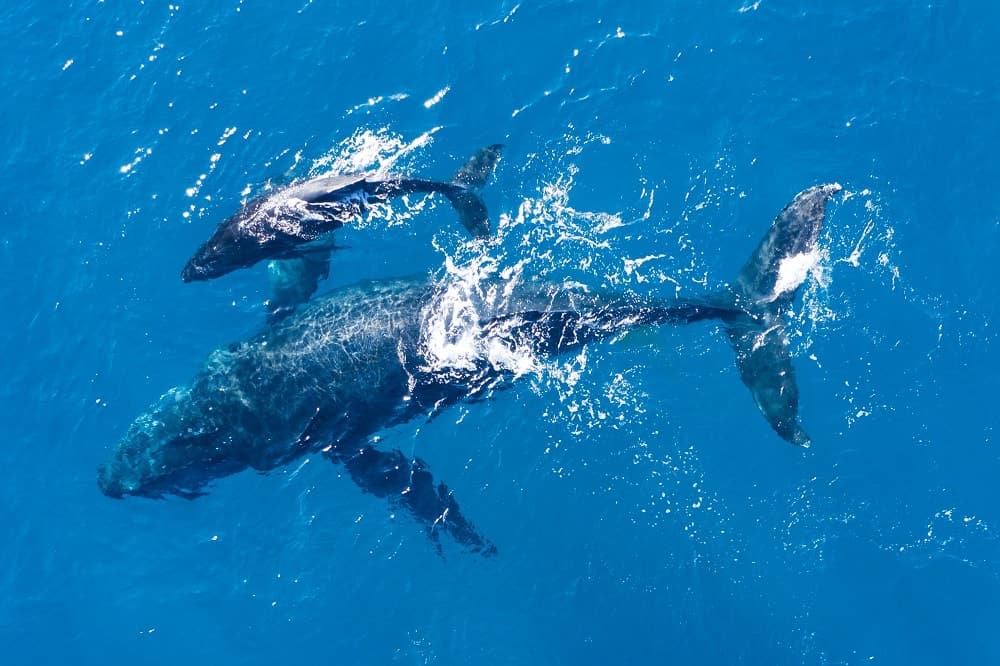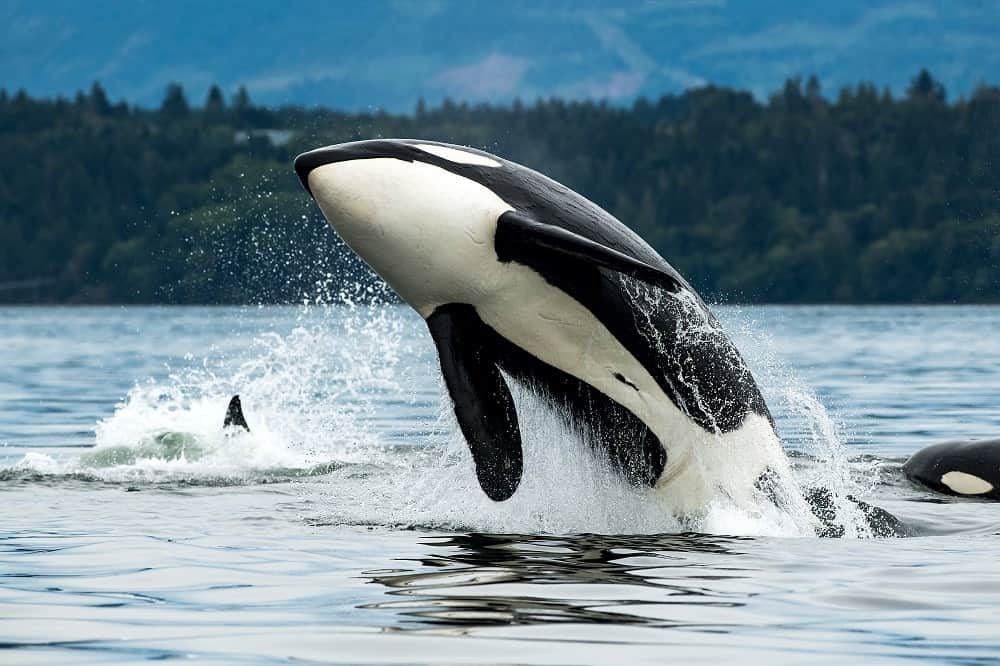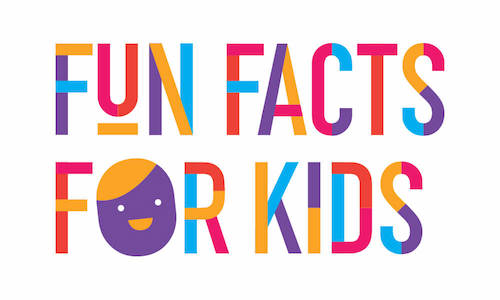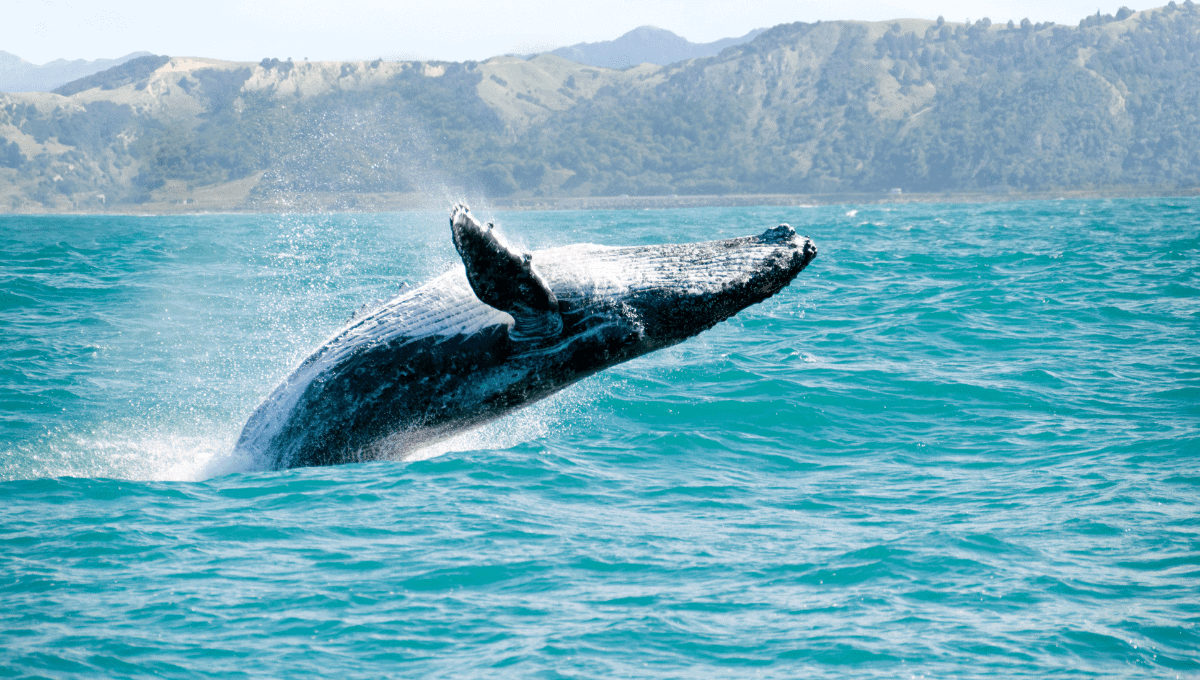Want to learn some fun facts about whales for your school presentation? Or are you a budding marine biologist and want to learn more interesting facts about whales because you love the ocean? This ‘facts about whales for kids’ article will tell you everything you need to know!
If you’re looking for other facts for kids, be sure to check out the rest of our facts for kids articles here.
Facts about whales: How many species of whales are there?
There are around 90 species of whale in the world. These majestic creatures are grouped into two categories: those with teeth (which are known as toothed whales or Odontoceti) and those which have what’s called a baleen plate in their mouth instead of teeth (these are known as baleen whales or Mysticeti).
The baleen whales are the really big whales such as blue whales and humpback whales. We’ll talk more about what a baleen plate actually is further down the article.
Did you know that dolphins and porpoises are also classed as whales? They are both types of toothed whales along with orcas!
We’ve very lucky here in Australia to be able to see whales migrate along our coastline. It’s one of the best countries in the world for whale watching!
Get these amazing whale stickers to embellish your project!
Whale facts for kids
Whales have blowholes to help them breathe. Whales breathe air just like other mammals. They have to come to the surface to get their air, and then they can dive down and stay under for a period of time before they need to resurface. How long they can stay under varies from species to species but whales can on average stay underwater for 60 minutes.
Whales must keep control of their blowhole to avoid drowning, so it’s thought they rest half of their brain at a time while they’re sleeping so they’re always aware.
Whales have flippers to help them move around in the water. A whale’s tail fin – also called its fluke – has two points to it and this is used to propel them through the water. A whale’s tail fin can also be a communication tool as they use it to slap the water’s surface to warn off predators or to impress a potential mate.
The collective noun for a group of whales is called a ‘pod’. Pods of whales can be small groups or very large groups. During the whale migration process, the whale pod provides security and protection.
Baleen whale facts
What is a baleen plate and how does it work?
A whale’s baleen plate is a bristly, fibrous, sieve-like filter that allows whales to suck in large quantities of seawater and trap their favourite foods inside their mouths. Think of it like a brush on the inside of their mouth that allows water to pass through but traps the food in its bristles.
Because baleen whales are so large, they need to eat a large amount of food to sustain them. This filter allows them to take in large amounts of water and food and filter out what they don’t need.
What are baleen plates made of?
The baleen plates are made of keratin, which is the same thing our fingernails and hair are made of! Incredibly, although these plates wear down they do grow back just like our fingernails do.
Toothed whale facts
Toothed whales are actually born with teeth. The number of teeth a toothed whale has depends on its species.
Toothed whales use their sonar system to hunt for food that includes squid and octopus. Their teeth help them grab their prey, although they often don’t chew it. Instead, they often swallow it whole although some might use their teeth to chomp their food a little and break it apart before swallowing.
How are toothed whales different to baleen whales?
Toothed whales have one opening in the blowhole. Baleen whales have two openings, and they are larger and they move more slowly.
The main difference between toothed whales and baleen whales is their feeding habits though. Having teeth allows you to eat in a very different way to having a baleen plate that allows you to suck in and filter your food!
Toothed whales hunt particular prey with precision, whereas a baleen whale eats lots of things all at once!
Baby whales: Facts about whale babies

Some species of whales travel a long distance to get to their chosen mating ground. When they arrive, the males (known as bulls) begin trying to gain their attention by showing off.
Whales aren’t monogamous, so they don’t choose a mate for life.
When a female whale is pregnant, the gestation period can last from ten to 18 months depending on the whale species.
Whales give birth to live young that are ready to swim alongside their mother. Whale babies are known as calves. A female whale (known as a cow) gives birth to a calf every one to six years. When the whale baby is born, it suckles milk from its mother for up to two years.
A female whale protects her calf and the pod provides added protection as they travel together.
Which is the largest whale in the world?
The Antarctic blue whale is not only the largest whale in the world, but it’s also the largest animal on the planet!
Antarctic blue whales can grow up to an incredible 30m in length! These guys need to eat a lot of food as they can weigh up to 200 tons!
Which whales are the largest toothed whale?
The largest toothed whale is the sperm whale. These grow up to around 19m in length and can weigh up to around 60 tons. Did you know that the sperm whale also has the largest brain?
We love these books about whales for kids!
How do whales communicate?

A whale song is the sound baleen whales make to communicate. The pattern of sounds is like an eerie song with notes repeating in a predictable pattern like a chorus.
These whale songs can be sung during mating season or while feeding. They can also be heard when a whale is mourning the loss of a loved one. Their songs vary depending on the occasion, but only male whales are known to sing. Females can, however, make calling sounds.
Scientists still haven’t fully understood the purpose of the whale song. There are still so many whale facts to uncover!
Are whales dangerous?
Whales generally aren’t dangerous creatures. Although whales are carnivores, they don’t usually attack people. It’s extremely rare to find instances of a whale hurting a human in the wild.
Whales facts: What are the threats to whales?
Whales face many threats. These include:
- Whaling: Whaling is the process of hunting whales and killing them for their meat, blubber, oil and body parts. While commercial whaling was banned in 1986 by the International Whaling Commission, some countries (Iceland, Norway and Japan) still actively engage in whaling.
- Getting tangled in fishing nets: Usually, whales and dolphins aren’t the aim of fishing nets, but they can get caught up and become an accidental catch.
- Boats (strikes and scares): An increase in shipping traffic means that more boat strikes happen to whales than ever before. As many shipping lanes cross with breeding grounds, this is an ongoing risk. Ships can also interfere with a whale’s communication which can separate them from their pod and put them in danger. The noise and interference from boats can also involve whales leaving an abundant area that is safe for their calves in order to move to a quieter place where there may be other risks.
- Climate change: Climate changes can damage food supplies, change water temperatures and acidity and cause a direct impact to whales’ habitats. The warming of our planet is causing huge challenges for our ocean creatures.
- Pollution and loss of habitat: Pollution is a real problem for our marine ecosystem. Plastics, rubbish, oil leaks…all of these damage a whale’s home.
Why are whales so important?
Whales are integral to our oceans as their movement circulates essential nutrients which support the marine ecosystem. Did you know that whale faeces (poo!) fertilises the ocean which in turn produces large phytoplankton blooms that are able to absorb massive volumes of carbon dioxide? Allowing whale populations to fully recover from past whaling will have a positive impact on helping to reduce greenhouse gas levels in our atmosphere, so whales have a true benefit to climate change!
Where can you go to see whales in the wild in Australia?
Here in Australia, we’re very lucky to have plenty of locations where we can see whales migrating. You can go whale watching along the coast near Hobart, Perth, Sydney, Adelaide, Brisbane and Melbourne. From some locations, you can see them from land and others you will need to go out on a whale-watching trip.
It’s well worth the effort to go whale watching – don’t forget your seasick tablets as the water can get choppy!
How can you help the whales?
You can be an advocate for whales and help others understand the challenges and threats whales face. There is also a lot we can do to support climate change (such as being more energy-efficient, travelling less, being more aware of what we’re eating…) as well as minimizing our use of single-use plastics which can find their way into the oceans and damage a whale’s habitat.
Check out these awesome whale posters for kids!
Facts about whales for kids: Did you love these fun facts about whales?
Did you find this post about facts for kids about whales useful? If so, please give it a share!
If you enjoyed this you might like to read some of our other animal facts for kids articles.
More facts for kids
If you have enjoyed these kids’ facts about whales and you are looking for more great facts for kids to help with projects, check out our other articles:
Animal facts for kids
- Quokka Facts for Kids
- Ant Facts for Kids
- Crocodile Facts for Kids
- Dolphin Facts for Kids
- Echidna Facts for Kids
- Bee Facts for Kids
- Australia’s Deadliest Animals Facts for Kids
- Cheetah Facts for Kids
- Endangered Animals Facts for Kids
- Kangaroo Facts for Kids
- Possum Facts for Kids
- Koala Facts for Kids
- Dog Facts for Kids
- Cat Facts for Kids
- Butterflies Facts for Kids
- Dingo Facts for Kids
- Turtle Facts for Kids
- Penguin Facts for Kids
- Wolf Facts for Kids
- Sustainability Facts for Kids
- Recycling Facts for Kids

